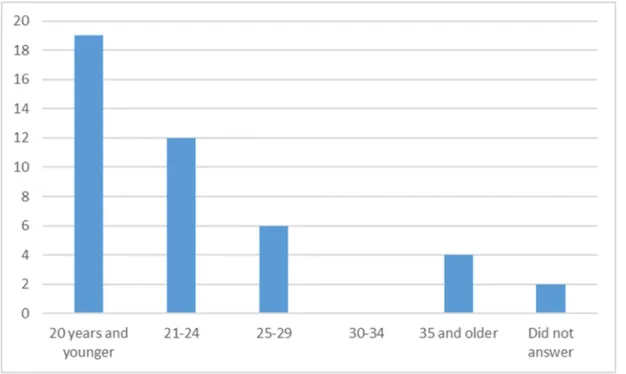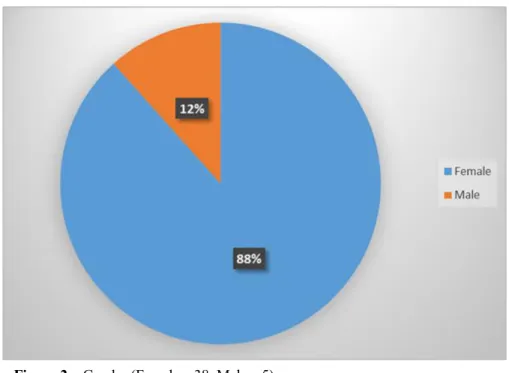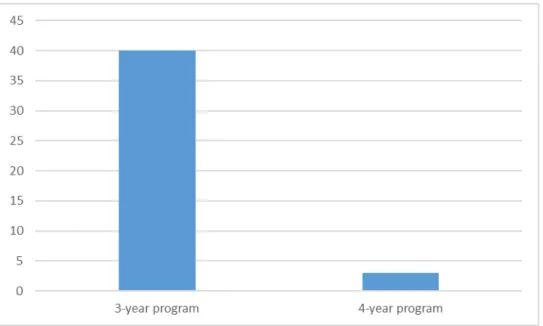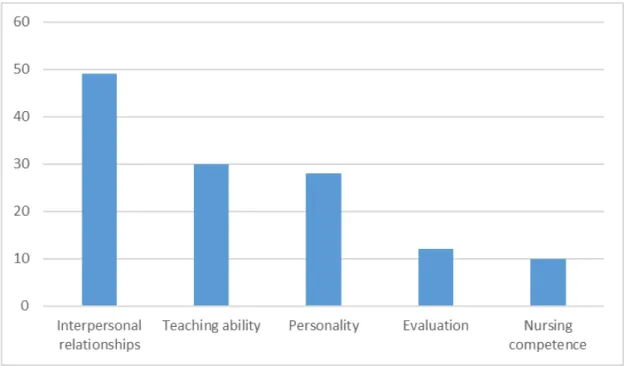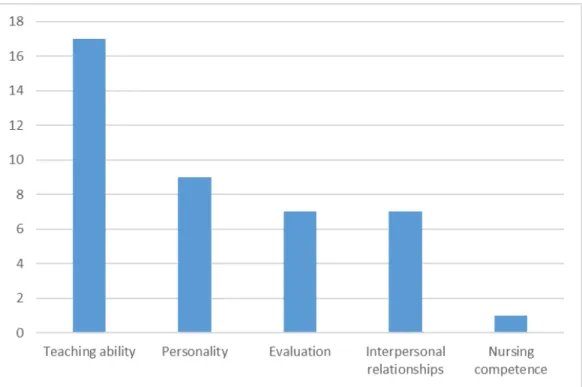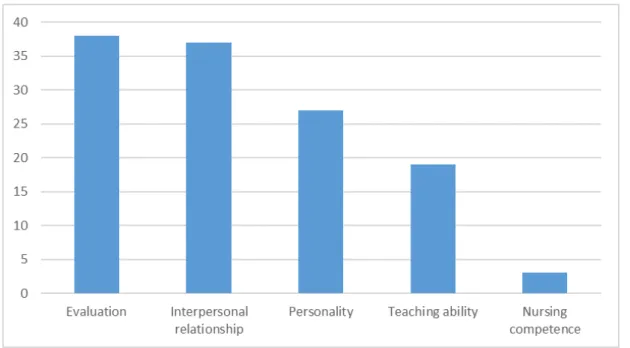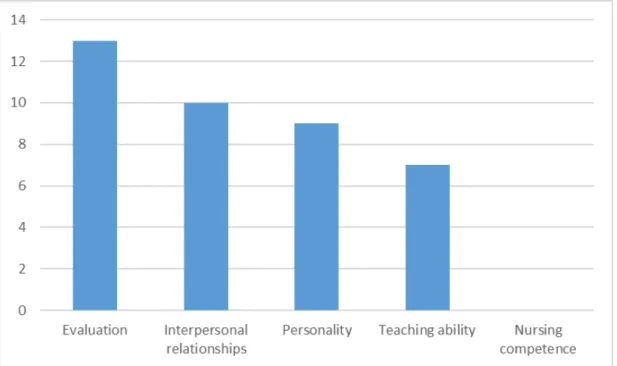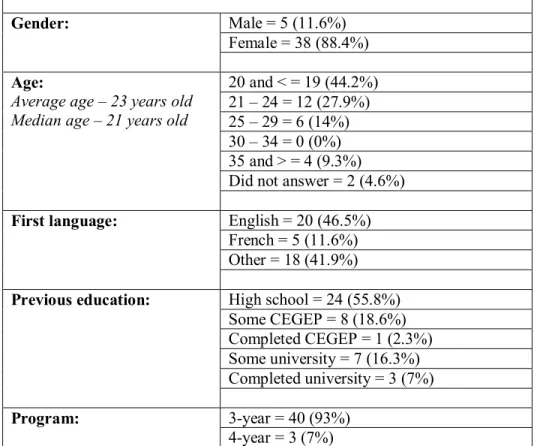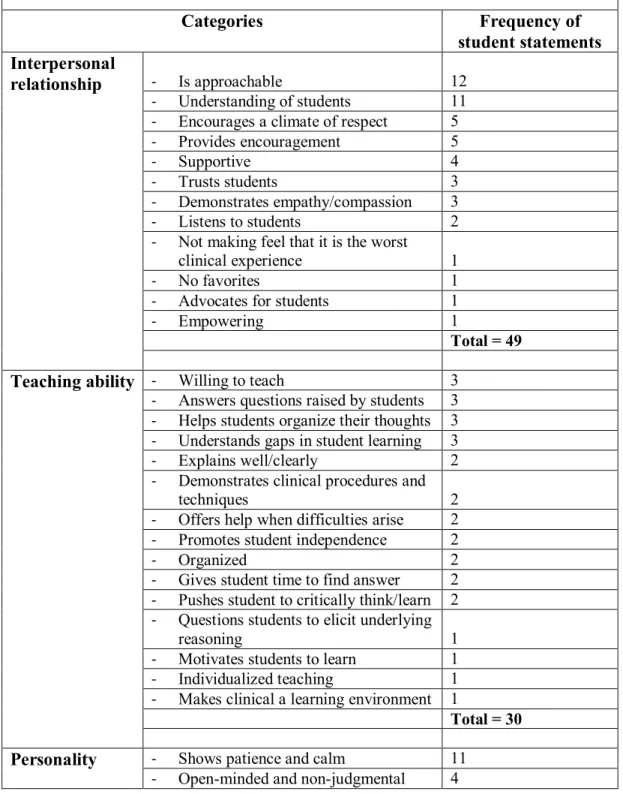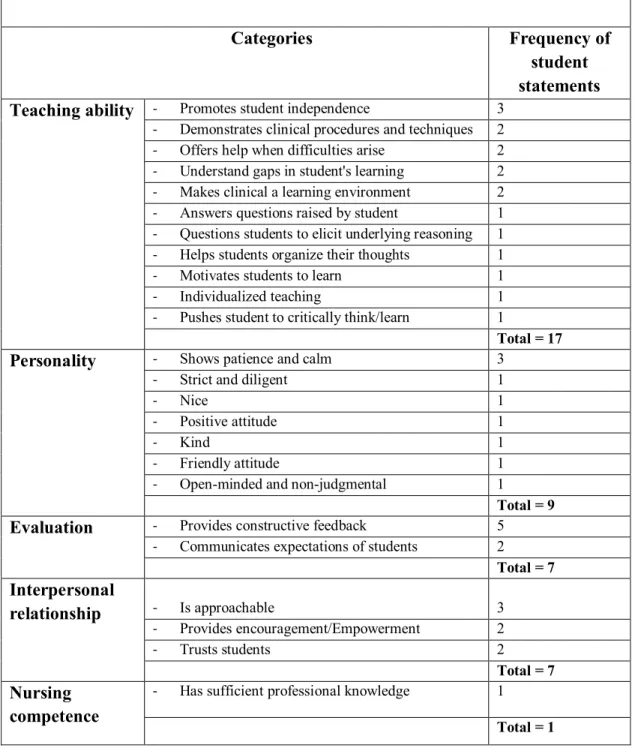Faculty of Education
THE INFLUENCE OF CLINICAL NURSING TEACHERS ON
CEGEP NURSING STUDENTS’ SELF-EFFICACY
A Masters Paper by
Juan Alejandro Robles
Submitted to the Faculty of Education in
Partial Fulfillment of the course: Conducting a Research Project (MEC 804) Performa: Master Teacher Program
May 21, 2018
UNIVERSITÉ DE SHERBROOKE
Faculty of Education
THE INFLUENCE OF CLINICAL NURSING TEACHERS ON
CEGEP NURSING STUDENTS’ SELF-EFFICACY
by
Juan Alejandro Robles
has been evaluated by a jury composed of the following persons:
______________________ _______________________
Stephen G. Taylor, PhD Christina Clausen, PhD
ABSTRACT
Clinical practicum is a fundamental part of nursing education. Clinical nursing teachers have an important responsibility in facilitating nursing student learning and shaping student experience in the clinical setting. However, clinical nursing teachers differ in nursing experiences and competencies, beliefs, attitudes, and teaching competencies. The differences that clinical nursing teachers bring in the clinical setting may support or hinder nursing student self-efficacy. Bandura’s Social Learning Theory and Cognitive Learning Theory are the theoretical frameworks of this research project. Self-efficacy, a central concept in Cognitive Learning Theory, is defined as the person’s beliefs about his or her capability to produce the outcomes he or she desires. This qualitative study had two purposes. First, it aimed to explore CEGEP nursing students’ perceptions of the characteristics and behaviors of the effective and ineffective clinical nursing teachers. Second, it intended to describe and investigate what clinical teacher characteristics and behaviours support and hinder CEGEP nursing student self-efficacy. A convenience sample of 43 students was drawn from 53 third year CEGEP nursing students. The students answered an open-ended questionnaire that required them to describe the characteristics and behaviours of their most effective and ineffective clinical nursing teachers. The questionnaire also asked how these characteristics and behaviours influenced their sense of self-efficacy. The instrument was a modified questionnaire by Kelly (2007). Data from this section were coded following the methods by Kelly (2007), Knox & Mogan (1985), and Tang, Chou, & Chiang (2005). Qualitative data from this section were analyzed for themes. Results supported the hypothesis that nursing clinical instructor characteristics and behaviours as perceived by CEGEP nursing students fit within five categories: nursing competence, teaching ability, evaluation, interpersonal relationships, and personality. The findings were also consistent with the hypothesis that evaluation influences CEGEP nursing students’ self-efficacy the most. These findings affirmed the need for proficient and highly skilled clinical instructors if the goal of nursing education within the clinical practicum is to support overall student success and facilitate learning in the clinical setting. This research has implications for clinical teacher education as well as evaluation practices.
Keywords in this research project included clinical instructor characteristics, student self-efficacy, clinical teaching, teaching ability, nursing student, clinical education, nursing competence, and student outcomes.
RESUMÉ
Le stage clinique est un élément fondamental de la formation en soins infirmiers. Les enseignants en soins infirmiers cliniques ont une responsabilité importante en facilitant l'apprentissage des étudiants en soins infirmiers et en façonnant l'expérience des étudiants dans le milieu clinique. Cependant, les enseignants en soins infirmiers cliniques diffèrent en ce qui a trait aux expériences et aux compétences infirmières, aux croyances, aux attitudes et aux compétences en enseignement. Les différences que les enseignants en soins infirmiers cliniques apportent dans le cadre clinique peuvent soutenir ou entraver l'auto-efficacité des étudiants en soins infirmiers. La théorie de l'apprentissage social de Bandura et la théorie de l'apprentissage cognitif sont les cadres théoriques de ce projet de recherche. L'auto-efficacité, un concept central de la théorie de l'apprentissage cognitif, est défini comme la croyance de la personne quant à sa capacité de produire les résultats qu'elle désire. Cette étude qualitative avait deux objectifs. D'abord, il visait à explorer les perceptions des étudiants en sciences infirmières du cégep sur les caractéristiques et les comportements des enseignants infirmiers cliniciens efficaces et inefficaces. Deuxièmement, il avait pour but de décrire et d'examiner les caractéristiques et les comportements des enseignants cliniques qui favorisent l'auto-efficacité des étudiants en sciences infirmières du cégep. Un échantillon de commodité de 43 étudiants a été tiré de 53 étudiants en sciences infirmières de troisième année du cégep. Les élèves ont répondu à un questionnaire ouvert qui les obligeait à décrire les caractéristiques et les comportements de leurs enseignants en soins infirmiers cliniques les plus efficaces et les plus inefficaces. Le questionnaire a également demandé comment ces caractéristiques et comportements influençaient leur sentiment d'auto-efficacité. L'instrument était un questionnaire modifié par Kelly (2007). Les données de cette section ont été codées selon les méthodes de Kelly (2007), Knox et Mogan (1985), et Tang, Chou et Chiang (2005). Les données qualitatives de cette section ont été analysées pour les thèmes. Les résultats appuient l'hypothèse selon laquelle les caractéristiques et les comportements des infirmières
cliniciennes en soins infirmiers, tels que perçus par les étudiants en soins infirmiers des cégeps, se classent dans cinq catégories: compétence infirmière, capacité d'enseignement, évaluation, relations interpersonnelles et personnalité. Les résultats concordent également avec l'hypothèse selon laquelle l'évaluation influence le plus l'auto-efficacité des étudiants en soins infirmiers du cégep. Ces constatations ont confirmé le besoin d'instructeurs cliniques compétents et hautement qualifiés si l'objectif de la formation en soins infirmiers dans le cadre du stage clinique est de favoriser la réussite globale des étudiants et de faciliter l'apprentissage en milieu clinique. Cette recherche a des implications sur la formation des enseignants cliniques ainsi que sur les pratiques d'évaluation.
Les mots clés de ce projet de recherche comprenaient les caractéristiques de l'instructeur clinique, l'auto-efficacité des élèves, l'enseignement clinique, la capacité d'enseignement, les étudiants en soins infirmiers, la formation clinique, les compétences en soins infirmiers et les résultats des élèves.
DEDICATION
This masters thesis is dedicated to my daughters Brianna, Lauren, and Megan who have always been my constant source of strength, encouragement, and motivation. This work is also dedicated to my wife Jeniffer who provided me with unconditional love and support, encouragement, and endless understanding specially during those rare moments of crisis. You all have sacrificed as much as I have during these past six years.
I would also like to say a special “Thank You” to my parents and other family members for the love, support, and encouragement.
ACKNOWLEDGEMENT
First and foremost, I would like to sincerely thank my adviser Dr. Stephen Taylor for his guidance and support throughout this research project. Dr. Taylor’s expertise and competency in research, teaching ability, approachable personality, and ability to establish a respectful learning environment fostered and supported my sense of self-efficacy.
To all my former MTP professors, thank you for your dedication to helping us CEGEP teachers become more effective educators. You all played an important role in my professional growth.
Finally, I would also like to thank all my MTP peers and my Vanier colleagues. The friendship and mutual support and encouragement made this journey a wonderful experience. I cannot list all your names here, but you will always be on my mind.
TABLE OF CONTENTS
ABSTRACT……..……….. iii RESUMÉ……… iv DEDICATION……… vi ACKNOWLEDGEMENT………. vii TABLE OF CONTENTS……….. ix INTRODUCTION……….. 1CHAPTER 1 PROBLEM STATEMENT……….... 3
CHAPTER 2 CONCEPTUAL FRAMEWORK……….. 7
CHAPTER 3 LITERATURE REVIEW 3.1 Literature………. 11
3.2 Research questions and hypothesis………. 18
CHAPTER 4 METHODOLOGY 4.1 Research design and setting……… 19
4.2 Sample population……….. 20
4.3 Instrument………... 20
4.4 Procedure……….... 22
4.5 Ethical considerations………. 23
CHAPTER 5 RESULTS AND DISCUSSION OF FINDINGS 5.1 Results………. 25
TABLE OF CONTENTS
CHAPTER 6 CONCLUSION
6.1 Limitations……….. 49 6.2 Implications for nursing education and future studies.... 49 6.3 Closing statement……….... 50 REFERENCES………... 53
APPENDIX 1 RESEARCH QUESTIONNAIRE………. 59
APPENDIX 2 VANIER COLLEGE RESEARCH ETHICS BOARD
RESEARCH CERTIFICATION……….. 67
APPENDIX 3 TABLE 1: Demographic data……….. 69
APPENDIX 4 TABLE 2: Important clinical teacher qualities and
behaviors for teaching effectively in the clinical setting….. 71
APPENDIX 5 TABLE 3: Qualities and behaviors that support
self-efficacy……….. 75
APPENDIX 6 TABLE 4: Qualities and behaviors that detract from
effective clinical teaching………. 77
APPENDIX 7 TABLE 5: Qualities and behaviors that diminish
self-efficacy……….. 81
LIST OF FIGURES
Figure 1: Age………... 25
TABLE OF CONTENTS
LIST OF FIGURESFigure 3: First language……….... 26
Figure 4: Program………. 27
Figure 5: Previous education prior to nursing……….. 27 Figure 6: Frequency of identified important clinical teacher
qualities and behaviours for teaching effectively………….. 28 Figure 7: Frequency of identified important clinical teacher
qualities and behaviours that support student
self-efficacy………... 33
Figure 8: Frequency of identified important clinical teacher
qualities and behaviours that detract from teaching
effectively………... 38
Figure 9: Frequency of identified important clinical teacher
INTRODUCTION
Clinical practicum is a fundamental part of nursing education. Clinical nursing teachers have an important responsibility in facilitating nursing student learning and shaping student experience in the clinical setting. However, clinical nursing teachers differ in nursing experiences and competencies, beliefs, attitudes, and teaching competencies. The differences that clinical nursing teachers bring in the clinical setting may support or hinder nursing student self-efficacy which impacts a student’s learning capacity and experience.
Bandura’s Social Learning Theory (SLT) and Social Cognitive Theory (SCT) are the theoretical frameworks for this research project. Self-efficacy, a central concept in SCT, is defined as the person’s beliefs about his or her capability to produce the outcomes he or she desires. Self-efficacy influences the individual cognitive ability that is involved in acquiring, structuring and using information.
The review of the literature focuses on the student perception of characteristics and behaviours of the effective and ineffective clinical instructor and their impact on nursing students’ self-efficacy in the clinical setting. Some keywords used for this review of the literature include clinical instructor characteristics, student self-efficacy, clinical teaching, teaching ability, nursing student, clinical education, nursing competence, and student outcomes.
The purpose of this qualitative research was twofold. First, it was designed to explore CEGEP nursing students’ perceptions of the characteristics and behaviours of the effective and ineffective clinical nursing teachers. The hypothesis is that nursing clinical instructor characteristics as perceived by CEGEP nursing students will fit within five categories: nursing competence, teaching ability, evaluation, interpersonal relationships, and personality. Second, it aimed to investigate and illustrate the clinical teacher characteristics and behaviours that mostly affect, positively and negatively, CEGEP nursing student self-efficacy. The hypothesis is that the evaluation category will have the most impact on CEGEP nursing students’ self-efficacy.
A convenience sample of 43 students was drawn from 53 third year CEGEP nursing students. Data collection was conducted in the Fall 2017 semester. The students were asked to answer an open-ended questionnaire which invited them to describe the characteristics and behaviours of their most effective and ineffective clinical nursing teachers. Data from this section were coded following the methods by Kelly (2007), Knox & Mogan (1985), and Tang, Chou, and Chang (2005). The students were also asked to describe how these clinical teacher characteristics and behaviours affected their self-efficacy beliefs. Qualitative data from this section were analyzed for themes.
Approval to conduct research from the Vanier College Research Ethics Board was obtained on October 4, 2017. Anonymity for nursing students and clinical teachers alike were assured. Student participation in this survey was voluntary. Students were informed that they may leave and return a blank survey without any repercussions if they did not wish to participate. Participation in the study did not have any impact on their academic and clinical marks. In addition, results of the study did not have any influence on any teacher evaluation.
The findings of this research were consistent with the stated hypothesis. First, the important qualities and behaviours for teaching effectively in the clinical setting and those that detract from effective clinical teaching fit in the identified dimensions. These dimensions are nursing competence, teaching ability, evaluation, interpersonal relationship, and personality. Second, results suggest that evaluation has the most influence on nursing student self-efficacy. Based on these results, some limitations of this study were identified. More importantly, key implications for nursing education and future studies were recognized.
CHAPTER 1: PROBLEM STATEMENT
Nursing education takes place in four main settings: the classroom, seminars, skills laboratories, and in clinical settings (Kelly, 2007). Clinical practicum is a vital part of nursing education (Elcigil & Sari, 2008; Kotzabassaki et al., 1997). In Quebec, becoming a nurse requires 1035 hours of clinical practicum. The goal of clinical education is to prepare students and help them acquire the knowledge and skills for providing safe and competent patient care (Valiee, Moridi, Khaledi, & Garibi, 2016). It is in the clinical setting that students get the opportunity to apply the concepts learned in the classroom and perform psychomotor skills learned in the lab (Mogan & Warbinek, 1994; Rowbotham & Owen, 2015). Furthermore, the clinical experience offers students the chance to master effective interaction and communication techniques with patients and their families, the interdisciplinary team and other healthcare providers (Rowbotham & Owen, 2015). Although students look forward to these experiences, aspects of the clinical setting such as relationships and socialization with staff, the type of interaction with the clinical teacher, feelings of inadequacy, and lack of knowledge may cause varying degrees of feelings of intimidation, anxiety, and stress (Cook, 2005; Mlek, 2011; Rowbotham & Owen, 2015; Wallace, Bourke, Tormoehlen, & Poe-Greskamp, 2015). Stress, anxiety, and feelings of intimidation can impede the students’ learning capacity, thereby decreasing a student’s level of self-efficacy (Corkett, Hatt, & Benevides, 2011; Wallace et al., 2015). Self-efficacy is the person’s beliefs about his or her ability to complete a task at a specific level of performance (Bandura, 1994). Self-efficacy impacts the individual’s cognitive ability to acquire, structure and use information in a given situation.
Nursing clinical instructors play an essential role not only in supporting the students’ learning experience (Lovric et al., 2014; Parsh, 2010; Rowbotham & Owen, 2015) and student self-efficacy beliefs, but they are also responsible for ensuring that patients receive competent and safe nursing care from their students (Tang et al., 2005). Modern nursing clinical education demands different competencies of nursing
clinical faculty (Lovric et al., 2014). The clinical teachers’ varied background and practices brought to the clinical area can either help or hinder student learning and self-efficacy. They differ in beliefs and philosophies, expertise, and experiences. These differences may explain the variety of approaches they use in their clinical practicum management. However, clinical faculty often lack the academic preparation in educational theories and practices (Kelly, 2007; Lovric et al., 2014). In addition, there is a lack of experienced clinical faculty available and many clinical teachers are often casually employed, not to mention the under-utilization of the clinical expertise of full-time academic faculty (Kelly, 2007). Consequently, nursing clinical instructors are often appointed to teaching roles where they are unqualified or unprepared to teach (Lee, Cholowski, & Williams, 2002). Imagine a clinical nursing teacher with expertise in pediatric nursing being assigned to teach in a gerontological setting. Although this clinical instructor can model critical thinking and judgement, one may argue that this clinical teacher may not be the most effective gerontology teacher because he or she may not be able to model to the students how an experienced gerontology nurse would respond to situations that are unique to a geriatric clinical setting. People often argue that “a nurse is a nurse is a nurse.” There is an assumption that any nurse will be able to function, or teach, in any nursing domain. This assumption may be true if nursing is minimized to a set of generic or basic skills and procedures such as safe medication preparation and administration. However, even this seemingly very basic skill requires a wide variation of approaches depending on the clinical context.
Due to the amount of learning, both theoretical and clinical skills, which needs to be accomplished in nursing, students often have feelings of fear and frustrations (Rowbotham & Schmitz, 2013) which impacts their self-efficacy and learning outcomes. To minimize these feelings, nursing students and clinical instructors need to develop a close working relationship in the clinical environment that fosters mutual respect and admiration (Tang et al., 2005). However, successful relationships have not always been the case. A number of studies suggest that feelings of frustrations and failure result from constrained relationships between clinical
teachers and nursing students (Tang et al., 2005).
Because clinical nursing instructors have a significant influence on nursing students’ feelings of success or failure in the clinical practicum (Tang et al., 2005), and because there is limited research on CEGEP nursing student perception on the qualities of effective and ineffective nursing clinical instructors, the focus of this research project is to examine CEGEP nursing students’ perceptions of the characteristics and behaviours of the effective and ineffective clinical instructors which may affect student self-efficacy. Findings of this research project will offer a list of teacher characteristics and behaviours to be developed and strengthened to support student self-efficacy, which in turn may support overall success in the clinical practicum in the CEGEP level. In addition, the results of this study will also offer a list of characteristics and behaviours to be avoided.
CHAPTER 2: CONCEPTUAL FRAMEWORK
Bandura’s Social Learning Theory (SLT) and Social Cognitive Theory (SCT) are the theoretical frameworks for this research project. The SLT centres on the learning that takes place within a social context (Bandura, 1971). The premise of SLT, which includes concepts such as observational learning, imitation and modelling, is that individuals learn from one another. In SCT, personal factors in the form of cognition, affect and biological events, behaviour, and environmental influences create interactions that result in a triadic reciprocality (Bandura, 1989). If nursing students can learn by observing other people and that modelling teaches new behaviours, then the clinical teacher’s expertise in a specific nursing field will prove to be fundamental. Domain-specific or content knowledge is defined as the teacher’s extent of knowledge of the discipline (Glover, Ronning, & Brunning, 1990; Tsui, 2003) that is acquired through lengthy contextualized experience (Berliner, 1994). Content-knowledge is therefore related to the clinical teacher’s expertise in a specific nursing domain.
Self-efficacy is a central concept in SCT. Defined as the person’s judgement about his/her competence to accomplish a task at a specified degree of performance, self-efficacy influences the individual cognitive ability that is involved in acquiring, structuring and using information (Bandura, 1994). There are four sources of self-efficacy: the experience of mastery, social modelling, social persuasion, and the perception of emotional and physical reactions (Bandura, 1994). A clinical setting atmosphere that incorporates all four self-efficacy sources is conducive to student learning. Considered as the strongest source of self-efficacy, the experience of mastery involves overcoming obstacles by investing effort. To attain mastery, the student needs to meet the demanding but not overstraining task. Certain students however, and because they are used to the traditional didactic approach to teaching, tend to play a passive role in the learning process (Sinclair & Ferguson, 2009). Consequently, learning becomes superficial and temporary. Second, social modelling involves observing someone who is successful in achieving something the student
aspires to accomplish. In this sense, nursing instructors serve as role models to their students. A student’s ability to accomplish or fail at a task is influenced by observing somebody whom the student believes to have similar ability when confronting a similar task (Corkett et al., 2011; Zulkosky, 2009). Third, social persuasion occurs when students are convinced by others (e.g. nursing instructors, parents, peers) that they have the competency to master any given clinical skill. Verbal persuasion and feedback about completing a task can increase or decrease self-efficacy (Corkett et al., 2011; Zulkosky, 2009). This source of motivation is also vital for student success (Rowbotham & Owen, 2015). Clinical nursing teachers need to utilize motivational teaching approaches to promote students’ self-regulated and autonomy-supportive behaviors. Unfortunately, because of lack of pedagogical preparation, clinical instructors may lack motivational teaching skills. Finally, it is not the intensity of the emotional and physical response but rather how these emotions and physical responses are perceived and interpreted that affects the development of self-efficacy. This may be related to the teacher’s personality and the student-teacher relationship.
As previously stated, clinical practicum is an essential part of nursing education. Yet, it is also a stressful time for nursing students (Rowbotham & Owen, 2015). Clinical nursing teachers have a major role to play in minimizing student stress and facilitating student learning in the clinical setting, thus supporting nursing student self-efficacy. However, nursing schools have not always supported student learning, which makes learning in the clinical setting even more difficult (Livsery, 2009 as quoted in Rowbotham & Owen, 2015). Clinical nursing teachers’ characteristics and behaviors have an impact on the students’ clinical experience, which in turn may also influence student self-efficacy. In this sense, it is vital that clinical nursing instructors acquire a good understanding of Bandura’s SLT and SCT as well as which clinical nursing teacher’s characteristics and behaviors help or hinder nursing student self-efficacy.
To further understand nursing students’ perceptions of the characteristics and behaviors of effective and ineffective nursing clinical instructors, and to try find ways to improve the outcome which is the overall student success in the clinical practicum,
a literature review in nursing education research that has examined the characteristics of the clinical nursing instructor and their effect on student self-efficacy was conducted. To do this, two research questions needed to be answered. First, what are the characteristics and behaviours of effective and ineffective nursing clinical teachers as perceived by CEGEP nursing students? Second, what clinical teacher characteristics and behaviours in the clinical setting affect CEGEP nursing student self-efficacy? Some key search words included clinical instructor characteristics, student self-efficacy, clinical teaching, teaching ability, nursing student, clinical education, nursing competence, and student outcomes.
CHAPTER 3: LITERATURE REVIEW
3.1 LITERATURE
The earliest documented research on nursing clinical teachers’ effectiveness and limitations dates back to 1965 (Lovric et al., 2014), while the first list of the most appreciated clinical faculty behaviors was defined by Jacobson in 1966 (as cited in Knox & Mogan, 1985). Since then, studies focusing on clinical teaching in nursing flourished. In addition, various researchers developed instruments to measure clinical teacher characteristics. Some examples of these instruments include the Clinical Teacher Characteristic Instrument (Brown, 1981 as cited in Lovric et al., 2014), the Nursing Clinical Teacher Effectiveness Inventory (NCTEI) (Knox & Mogan, 1985), the Clinical Instructors’ Effective Teaching Strategies Inventory (Valiee et al., 2016), and the Observations of Nursing Teachers in Clinical Settings (Mogan & Warbinek, 1994). Despite the different tools used in identifying the important teacher characteristics, the researchers more or less identified similar categories or dimensions. These categories are nursing competence, teaching ability, evaluation, interpersonal relationship, and personality (Elcigil & Sari, 2008; Mogan & Knox, 1987). However, results of those studies are non-comparable because of differing data collection methodologies (Kelly, 2007; Kotzabassaki et al., 1997).
The review of the literature focuses on the student perception of characteristics and behaviours of the ineffective and effective clinical instructor and their impact on nursing students’ self-efficacy in the clinical setting.
3.1.1 The ineffective clinical instructor
There are important commonalities among the research findings on the characteristics and behaviours of ineffective clinical teachers over the years. Students rate their “worst” clinical teachers as those who are not good role models, who fail to recognize their own limitation and who do not use constructive self-criticism, not
providing support and encouragement, lacking respect and empathy such as belittling students when they make mistakes, and ineffective communication skills (Cook, 2005; Knox & Mogan, 1985; Kotzabassaki et al., 1997; Mogan & Knox, 1987; Mogan & Warbenik, 1994; Nehring, 1990; Tang et al., 2005).
Other undesirable teaching behaviours include giving needless directions and/or explanations, incorrect information and unclear cues, missing teachable moments, and using sarcasm and inappropriate humour (Mogan & Warbinek, 1994). In addition, students do not appreciate being treated as irresponsible adults (Cook, 2005). Finally, clinical teachers who are unable to stimulate student interest in the subject is also rated as an unfavourable clinical teacher attribute (Kotzabassaki et al., 1997).
3.1.2 The effective clinical instructor
There are five general teaching attributes or categories that can influence student learning: nursing competence, teaching ability, evaluation, interpersonal relationship, and personality (Knox & Mogan, 1985). The literature suggests that Knox and Mogan’s definitions of these general teaching attributes or categories are the most cited and accepted definitions by many other researchers. Although research findings on the perceived characteristics of the effective and ineffective clinical teachers are more or less similar over the years, the rankings of the above attributes in terms of importance vary over the years and from one study to the other. A likely explanation for this is the changing student expectations and assessments over time as well as the influence of various elements such as peers, clinical faculty, the clinical environment and the changes in the clinical education systems (Kelly, 2007; Lovric et al., 2014). Some studies suggest a link between the differences of rankings of the classifications and cultural factors (Lee et al., 2002; Nahas, Nour, & Al-Nobani, 1999). In addition, the literature also suggests important similarities and differences between nursing students’ and clinical teachers’ perceptions of the traits and characteristics of effective clinical teachers (Kotzabassaki et al., 1997; Lee et al., 2002; Mogan & Knox, 1987;
Nehring, 1990; Parsh, 2010). These differences may be related to the teachers’ obligation to their educational institution which competes with occasions to practice nursing and a reflection of clinical teachers having been educated as nurses prior to becoming nursing faculty (Knox & Mogan, 1985).
3.1.2.1 Nursing competence
Nursing competence is the clinical teacher’s theoretical knowledge and clinical skills used in their professional nursing practice as well as the faculty’s attitude toward the profession (Knox & Mogan, 1985). Other experts also refer to this as domain-specific or content knowledge (Glover et al., 1990; Tsui, 2003). Students expect their clinical teachers to be knowledgeable in the clinical setting they are in and demonstrate sound clinical judgement and communication skills, which make these clinical instructors good role models for them (Elcigil & Sari, 2008; Kelly, 2007; Lee et al., 2002; Mogan & Knox, 1987; Nahas et al., 1999). Another important characteristic is the clinical teacher who enjoys nursing and takes responsibility for his/her own actions (Kotzabassaki et al., 1997).
Clinical expertise is fundamental in the delivery of evidence-based practice in healthcare (King et al., 2008). In addition, clinical experience is recognized as one important and necessary part of the nursing educational process (Daley, 2001; Kotzabassaki et al., 1997; Mogan & Knox, 1987). In this sense, expertise in a field or the clinical instructor’s expertise in a nursing specialty where the clinical educator teaches in plays an important role in teacher effectiveness and student learning. A clinical teacher who has expertise in pediatric nursing and teaches in the same domain will be able to model the desired skills and techniques and the appropriate behaviors. Domain-specific knowledge and expertise are closely related as both are acquired and developed thru years of contextualized experience in a specific domain or discipline (Berliner, 1994; Glover et al., 1990; Tsui, 2003).
3.1.2.2 Teaching ability
The second category of characteristics of an effective clinical instructor is the clinical instructor’s ability to teach. Teaching ability is the mode of diffusion of knowledge, attitudes and skills, and the creation of the tone or ambiance in which this is done (Knox & Mogan, 1985). For effective student learning to occur, clinical teachers need to connect their domain-specific knowledge (clinical expertise) with the theoretical and practical knowledge about teaching and learning (pedagogical and pedagogical-content knowledge) (Tsui, 2003).
The traditional “see one, do one and teach one” teaching approach, which has been used to teach nursing competencies and to promote the acquisition of clinical expertise, is no longer accepted as best practice to teaching nursing students (Leigh, 2008). The same can be said to the “one-technique fits all” (e.g. lecture and group demonstration of nursing skills) approach where a teacher uses the same teaching methodology regardless of the desired learning outcome and the “learning styles” (or the intelligence) of the learner (Sinclair & Ferguson, 2009). A football game metaphor suggests that the teaching approach should fit the desired learning outcome (Palincsar, 1986). This metaphor suggests that a good team should not only have a number of strategies or game plans, but the team should also be able to use the right strategy that best fits the play if the team wants to be effective. In addition, the team should continually evaluate the strategy during and after the game so members can make appropriate adjustments. When translated into clinical teaching, clinical educators need to possess a variety of approaches from which they can choose the best match for the desired learning outcome and the type of learner.
Nursing students identify the following teaching abilities of an effective clinical mentor: acts as advisor and guide, explains clinical practices, answers questions, demonstrates clinical procedures and techniques, and helps students identify and make use of practice opportunities (Elcigil & Sari, 2008; Lee et al., 2002). In addition, students expect their clinical teachers to demonstrate new skills and coach students through the skill and encourage practice (Elcigil & Sari, 2008;
Kelly, 2007; Kotzabassaki et al., 1997; Parsh, 2010), direct the students to the correct answer or where to find the answer (Elcigil & Sari, 2008; Parsh, 2010), and inform students about expectations (Valiee et al., 2016).
3.1.2.3 Evaluation
Evaluation is the quality and quantity of feedback the student receives from the teacher regarding clinical performance and written clinical assignments (Knox & Mogan, 1985). A recent study suggests that student perception of self-efficacy is significantly related with evaluation (Rowbotham & Owen, 2015). The clinical instructor who proposes ways for improvement, identifies strengths and weaknesses of students, observes frequently, communicates expectations, gives positive reinforcements, and corrects without belittling had students who reported higher self-efficacy. Evaluation is crucial for effective student learning because offering constructive feedback can motivate students to learn more, work collaboratively not only with the clinical teacher but also with other students, and develop sound clinical judgement (Rowbotham & Owen, 2015). Feedback needs to be frequent, must specify what is expected of the students (Mohamed-Nabil Ismail, Mohamed-Nabil Aboushadi, & Eswi, 2016; Nehring, 1990) and provided in a clear, direct and enthusiastic way (Lee et al., 2002; Parsh, 2010).
Other specific clinical teacher behaviours within this category rated by nursing students as important are fairness in grading, providing insight and criticism, giving reinforcement, pointing out improvement, encouraging self-evaluation (Viverais-Dresler & Kutschke, 2001), promoting independence (Mogan & Knox, 1987), and not only listening before providing feedback (Kelly, 2007), but also gives positive feedback (Mogan & Warbinek, 1994).
3.1.2.4 Interpersonal relationship
Interpersonal relationship is the state of mutual advantage or communication between two or more persons excluding specific therapeutic interaction between the nurse and the patient (Knox & Mogan, 1985). The quality of the association between the learner and the educator influences the success of the student-teacher relationship (Wills, 1997). Empirical literature suggests that a positive student-teacher relationship, defined as “warm, close, communicative,” is positively related to behavioural competence and has a significant influence on overall school and behavioural adjustment (Yoon, 2002). The most frequent clinical teacher behaviour identified by students within this set of attributes is being helpful to their learning (Elcigil & Sari, 2008; Nahas et al., 1999; Parsh, 2010; Tang et al., 2005). Other most rated characteristics include encouraging a climate of mutual respect, communication capabilities including attentive listening, empathy, motivation, availability, and engaging students (Elcigil & Sari, 2008; Kotzabassaki et al., 1997; Lee et al., 2002; Parsh, 2010).
Maturational and cultural factors need to be considered when making teaching decisions that affect the student-teacher relationships (Tsui, 2003). Most of the CEGEP students are emerging adults. They have varying relationship experiences that may influence how they learn and how they expect to interact with their teachers (Arnett, 2007). In addition, students in this age-group are in a transition period between the rapidly developing cognitive processes of childhood and the mature cognitive processes of young adulthood (Atea, Kail, & Cavanagh, 2009) which influences their reasoning about moral issues (Dahl, 2004; Powell, 2006), which may also have significant effect on motivation, emotion, learning and relationships with others. Socio-cultural differences affect moral reasoning as well. These differences have a bearing on student beliefs and attitudes towards knowledge and learning: surface versus deep approach (Biggs, 1999), the different ways of knowing (Baxter-Magolda, 1992), and the Perry schema of intellectual and ethical development (Moore, 1994).
teaching strategies (Malouff, Hall, Schutte, & Rooke, 2010) and autonomy-supportive teacher behaviours that should be developed and controlling behaviours which must be avoided (Reeve & Jang, 2006). These traits, including the other aforementioned behaviours, assist the clinical instructors to be more approachable, which can facilitate a more effective student-teacher interaction.
3.1.2.5 Personality
Personality, the final set of clinical instructor attribute, is the totality of the teacher’s attitude, emotional tendencies and character traits which are not specifically related to teaching, nursing or interpersonal relationships but may affect all three (Knox & Mogan, 1985). It has been suggested that teacher personality is probably the most important factor in determining success in classroom management and discipline (Kindsvetter, 1997 as cited in Savage & Savage, 2010). There is a positive relationship between the clinical teacher’s emotional intelligence and clinical teaching effectiveness (Allen, Ploeg, & Kaasalainen, 2012). Students describe the effective clinical instructor as somebody who is patient, respectful, supportive, and displays a love for teaching and enjoys sharing professional experiences with the students (Parsh, 2010). In addition, students also expect their clinical instructor to be positive, smiles, and stands up for them in difficult situations (Elcigil & Sari, 2008; Kotzabassaki et al., 1997). Other important personality traits include being organized (Kotzabassaki et al., 1997), self-confident (Lee et al., 2002; Mogan & Knox, 1987), and has a good sense of humour (Mohamed-Nabil Ismail et al., 2016; Nahas et al., 1999).
3.1.3 Influence of clinical teacher characteristics and behaviours on student self-efficacy in the clinical setting
Nursing education research has examined the effects of clinical instructor behaviours and characteristics on students in the clinical setting. Studies have shown a relationship between instructor behaviours and student stress (Mlek, 2011; Wallace et
al., 2015) and instructor behaviours and student anxiety (Cook, 2005; Mlek, 2011). Other research focused on the relationship between clinical instruction and critical-thinking and decision-making skills (Tanda & Denham, 2009).
While several studies have examined student self-efficacy in relation to the use of simulation (Cardoza & Hood, 2012; Leigh, 2008; Pike & O’Donnell, 2010; Shinnick, Woo, Horwich, & Steadman, 2011; Sinclair & Ferguson, 2009) and student confidence in the performance of nursing skills and clinical reasoning skills (Bambini, Washburn, & Perkins, 2009; Bin Mohammed, Quasimi, & Al-Nahyan, 2015; Kuiper, Pesut, & Kautz, 2009), investigative efforts specific to clinical teacher characteristics and behaviours in the clinical setting that may influence student self-efficacy are currently scarce (Rowbotham & Owen, 2015).
3.2 RESEARCH QUESTIONS AND HYPOTHESIS
The purpose of this research project was to examine the influence of the characteristics and behaviours of clinical nursing teachers as perceived by CEGEP nursing students on student self-efficacy. To conduct this analysis, two research questions needed to be answered:
R.Q. 1: What are the characteristics and behaviours of effective and ineffective
nursing clinical teachers as perceived by CEGEP nursing students?
Hypothesis 1: The nursing clinical instructor characteristics and behaviours as
perceived by CEGEP nursing students will fit within the five categories previously identified: nursing competence, teaching ability, evaluation, interpersonal relationships, and personality (Kelly, 2007; Knox & Mogan, 1985; Tang et al., 2005).
R.Q. 2: What clinical teacher characteristics and behaviours in the clinical
setting affect, positively and negatively, CEGEP nursing student self-efficacy?
Hypothesis 2: The evaluation category will have the most impact on CEGEP
CHAPTER 4: METHODOLOGY
4.1 RESEARCH DESIGN AND SETTING
This qualitative, exploratory, and descriptive research project was conducted at Vanier College Nursing Department. A qualitative approach was chosen to allow free-flowing description of students’ perceptions of their clinical instructors without disturbing or influencing their thought processes. This study was guided by previous research conducted by Knox and Mogan (1985), Tang et al (2005), Kelly (2007), and Rowbotham and Owen (2015).
Knox and Mogan (1985) developed the NCTEI, the most widely used instrument in several studies worldwide and notably the most cited survey instrument for research of clinical teaching behaviours in the literature (Kube, 2010; Lee et al., 2002). The NCTEI, a Likert-type scale survey tool used to rate the characteristics of the best and worst clinical instructor behaviours as experienced by students, consists of 47 items describing clinical teacher behaviours divided into five categories: teaching ability, nursing competence, personality traits, interpersonal relations, and evaluations. Tang et al (2005) and Kelly’s (2007) research offered additional insight on how students perceive effective and ineffective clinical teaching. Finally, Rowbotham and Owen (2015) used the NCTEI and the student self-efficacy (SSE) questionnaire to study the effect of clinical nursing instructors on student self-efficacy.
The Vanier College nursing program consists of three years/six semesters leading to a Diplôme d’Études Collegial (DEC). In Quebec, a DEC in nursing is the minimum entry-to-practice requirement into the nursing profession. Vanier College accepts roughly 100 first year nursing students every year. In the coming 2018-2019 academic year for example, there are 106 projected first year nursing students enrolled in the program. New and current students have the option to register in the extended four-year program, though most students opt to follow the regular three-year program. The program offers students courses in nursing theory, nursing-related courses such as biology and psychology, and general education. Nursing instructors supervise, guide,
and evaluate nursing students’ clinical experience in a wide variety of clinical placements, including but not limited to, acute medical and surgical units, long-term care facilities, gerontology, paediatrics, psychiatry, and maternal-newborn/post-partum wards.
4.2 SAMPLE POPULATION
A convenience sample of 43 students was drawn from a class of 53 third year nursing students. First and second year students were excluded from this study. First year (first semester) nursing students had not had any clinical experience as they only start their clinical practicum in the second half of the first semester. Second year (third semester) students only have had a maximum of three clinical teachers. Students in their final year (fifth semester) already have had the necessary exposure (780 clinical practicum hours) and experience to rate their clinical instructors.
4.3 INSTRUMENT
The written questionnaire consists of three main sections: demographics, student perception of the characteristics and behaviours of the effective and ineffective nursing clinical instructor, and the impact of the clinical teacher’s characteristics and behaviours on student self-efficacy. In the demographic section, the participants were asked to provide personal data such as age, gender, first language, the type of nursing program they are in, and previous level of education prior to registering to the Vanier College nursing program. Information in this section provided insight on the results of this study.
Data on student perception of the characteristics and behaviours of the effective and ineffective nursing clinical instructor and the effect on student self-efficacy were gathered using a modified version of Kelly’s (2007) research questionnaire. Kelly’s questionnaire was chosen because the questions are broad and open-ended that it can capture contextual influences on students’ perceptions of the effective and ineffective
clinical teaching. Thus, the survey questionnaire is consistent with the research questions.
For the effective nursing clinical instructor, the following questions were asked (see Appendix 1 for the copy of the questionnaire):
1. Thinking of the most effective clinical teacher you have had to date, provide a detailed description of what made that teacher effective for you.
2. What three clinical teacher characteristics and/or behaviours do you believe are most important for teaching effectively in the clinical setting? Rank these in order (1=most important, 2=second most important, 3=third most important). 3. Self-efficacy is defined here as your beliefs about your capability to produce the
outcomes that you desire (e.g. mastery of skills and knowledge development in the clinical setting). In what you have shared so far in question 2, which one characteristic or behaviour has enhanced your self-efficacy? Please explain how it supported the development of your self-efficacy.
For the ineffective nursing clinical instructor, the following questions were asked: 1. Thinking of the most ineffective clinical teacher you have had to date, provide a
detailed description of what made that teacher ineffective for you.
2. What three clinical teacher characteristics and/or behaviours do you believe detract from teaching effectively in the clinical setting? Rank these in order (1=mostly detracts, 2=second mostly detracts, 3=third mostly detracts). 3. Self-efficacy is defined here as your beliefs about your capability to produce the
outcomes that you desire (e.g. mastery of skills and knowledge development in the clinical setting). In what you have shared so far in question 2, which one characteristic or behaviour has diminished your self-efficacy? Please explain how it hindered the development of your self-efficacy.
4.4 PROCEDURE
4.4.1 Recruitment and data collection
Recruitment and data collection was conducted on a day when class was scheduled for three hours but the teacher only needed a maximum of two hours, and therefore no time was taken away from student learning. Paper copies of the questionnaire were distributed by the researcher in the Fall 2017 semester after explaining the purpose of this study. The researcher was not a teacher for these students. The students were informed that participation in this study was voluntary and anonymous. They were advised that they were free to leave and return a blank questionnaire if they did not wish to participate in the study. The students were asked to complete the written questionnaire by reflecting on their most effective and ineffective nursing clinical instructor (past and/or present). They were allowed class time (30 minutes) to complete the questionnaires.
4.4.2 Data analysis
The completed questionnaires were given to a third party for inspection of any identifying data as soon as the researcher received the forms. Then, qualitative data were transcribed word-for-word from the questionnaires. The researcher reviewed how Kelly (2007), Knox & Mogan (1985), and Tang et al (2005) classified and coded each of the nursing clinical teacher characteristics and behaviours. Following this review, a synthesized document was created, resulting in a broader list of teacher characteristics and behaviours which were categorized in the same five general attributes: nursing competence, teaching ability, evaluation, interpersonal relationship, and personality. Using a constant comparison method to analyze the students’ perceptions, each subject’s statement was compared then coded to match the characteristics and behaviours in the synthesized list. However, students used different terms to identify their perceptions of the characteristic and behaviors of the
effective and ineffective clinical nursing teachers, which made the comparison and categorization challenging. For example, the terms “too high expectations” and “unrealistic expectations” may mean the same to some students, but may be interpreted differently by others. The five main categories of data were identified in descending order of importance and frequency. In addition, information addressing student self-efficacy were analyzed for themes. The analysis process was also challenging due to some of the students' ability to describe, in writing, the impact of the clinical teacher on their self-efficacy. For instance, student 1’s use of grammar and sentence structure made it difficult to analyze.
4.5 ETHICAL CONSIDERATIONS
Official permission to conduct research from the Vanier College Research Ethics Board was obtained on October 4, 2017 (see Appendix 2 for the copy of the certificate). Permission from the third-year teaching team to meet with the students to provide information about the study and conduct the research was obtained prior to meeting with the class to discuss recruitment and data collection. Once permission to meet with the students was granted, recruitment and data collection date was established in coordination with the teacher who was going to be teaching on the chosen day. The researcher introduced himself to third year nursing students as he was not teaching nor expected to teach any of those students. Information about the aim of the study was offered to obtain their consent and acceptance to be participants in the study.
Participation in this research was voluntary. The students were informed that they could simply return a blank survey and leave without any repercussions if they did not wish to participate.
Anonymity was assured. First, the questionnaires were anonymously answered and there was no identifying information on the questionnaires. Second, the completed questionnaires were placed in a sealed envelope. Then, a third party went through the
questionnaires to ensure that there was no identifying information (teachers and students) in the questionnaires. Identifying data, if any, were stricken off the questionnaires before being returned to the researcher.
The students were assured that participation in this study would not have any influence on their academic and clinical marks. In addition, they were informed that there were no personal benefits or harms associated with their participation in this research, but the program and future students may benefit from improved supervision and teaching during clinical practicum.
The research project proposal was presented at the nursing department meeting at the beginning of the Fall semester. Faculty were assured that any identifying information would be taken out of the questionnaire by a third party. In addition, the teachers were informed that the results of the study would have no influence on any teacher evaluation.
CHAPTER 5: RESULTS AND DISCUSSION OF FINDINGS
5.1 RESULTS5.1.1 Participant profile
Forty-three of the 53 graduating nursing students were present during data collection, all of whom elected to participate and answered the questionnaire (100% participation). Student ages ranged from 19 years to 38 years old (Figure 1). Two students did not indicate their ages. The average age is 23 years old, while the median age is 21 years.
There were five male students (11.6%) and 38 female students (88.4%) (Figure 2).
Twenty students indicated that their first language is English (46.5%), five are Francophones (11.6%), and 18 as others (41.9%) (Figure 3).
Forty students are in the regular three-year program, while three are in the extended four-year program (Figure 4).
Twenty-four students (55.8%) went directly from secondary school into nursing, while nine students already had some CEGEP or completed CEGEP before studying nursing. Ten students have some or completed university education prior to taking nursing (Figure 5).
Figure 5: Previous education prior to nursing
The following results are divided into four sections or themes: the important
clinical teacher qualities and behaviours for teaching effectively in the clinical setting, clinical teacher qualities and behaviours that support student self-efficacy, the qualities and behaviours that detract from teaching effectively in the clinical setting, and clinical teacher behaviours and characteristics that decrease student self-efficacy. The findings are in descending order of importance and frequency by categories.
5.1.2 Important qualities and behaviours for teaching effectively in the clinical setting
In the analysis of the student description of what made their clinical teacher effective and what they think the important qualities and behaviours are, interpersonal relations between the teacher and the student ranked the highest, followed by the clinical instructor’s teaching ability, then by the teacher’s personality (Figure 6). Evaluation and nursing competence are at the bottom of the list. For more detailed
Figure 6 – Frequency of identified important clinical teacher qualities and behaviours for teaching effectively by category.
and breakdown of specific qualities and behaviours of the effective clinical teacher, refer to Table 2 in Appendix 3.
The majority of identified important qualities and behaviours fall under the interpersonal relationship category. In this category, the characteristic students identified most frequently is being approachable. The following student statements explain how being approachable made their clinical teachers effective:
“She was approachable and did not make me feel nervous by her presence. When I was nervous, she assured me that I can do it and she continued reassuring the things that I do right (Student 29).”
“The teacher had a very approachable attitude. She wouldn’t intimidate us; push us to work hard, but always there to help if we’re not familiar with something (Student 35).”
The following two statements captured how being approachable facilitated the students to ask their clinical teachers questions:
“Approachable, never gave the feeling of why questions were asked or making you feel that question was stupid (Student 7).”
“They were approachable to discuss what questions I had and in turn, this guided me (Student 13).”
The second most identified important quality of the effective clinical teacher is someone who understands the students’ personal life situations. One student felt that the clinical teacher’s understanding attitude contributed to her learning because she felt that she could trust her teacher: “(The teacher) had a very open and
understanding attitude which contributed to my learning. I felt like I could trust this teacher and open up to (the teacher) if I had any concerns (Student 16).” Another
student appreciated that her clinical teacher understood how it is like to be a student:
“The teacher understands how it is like to be a student and puts herself in our shoes. Because of this, she is very approachable, she portrays a caring environment (Student 34).”
The third most important behaviour is when the clinical teacher encourages a
climate of respect. Student 5 explained: “Even though (the teacher) was strict with evaluations, she always tries to get the best from a student by using a respective environment.” Another student (Student 6) stated that she “never felt intimidated, rather highly respected and very encouraged” in her practice.
Other important qualities and behaviours for teaching effectively which falls under the interpersonal relationships category include the following: provides
encouragement, supportive, trusts students, demonstrates empathy/compassion, and listens to students.
The second set of important qualities and behaviours for teaching effectively in the clinical setting fall under the clinical instructor’s teaching ability dimension. The teacher who is willing to teach topped this list. Students appreciate teachers who provided and shared new knowledge, told stories about past experiences, and gave many examples. The following statement describes the effect of the teacher who was willing to teach in student learning: “That teacher was approachable and was willing
to share knowledge and insight which made the learning easier for my clinical experience (Student 14).” In addition to teaching, students expressed that it is
important for teachers to answer questions raised by them.
The next three quotes spoke of the importance of teachers’ understanding of
gaps in student learning:
“Fostered a learning environment by allowing us to make mistakes while observing us attentively; not expecting us to be perfect the first time we do a skill outside of the school/labs (Student 3).”
“That teacher made clinical a learning environment and not a boot camp. The teacher was able to recognize when my anxiety was increasing and needed to stop her questioning (Student 15).”
“He/she understands the limits of the students. Does not push the student beyond their level to make them feel uncomfortable (Student 21).
The following testimony demonstrates the effect of promoting student
(dressing change, etc.) independently after observed once – this allowed me to be more confident and comfortable with the skill (Student 33).”
The next passages reveal the impact of pushing the students to think
critically/learn on learning:
“The teacher made an impact on me because she pushed me to the breaking point. She sets a very high standard and expected me to surpass it. I gained enormous amount of knowledge from her. She expected me to be a nurse, not a student (Student 3).”
“This particular teacher pushes to the very limit to the point of possible tears. It is a
good thing because nursing is a career with multiple stressors and we have to toughen up as students before we join the workforce. Pushing to the limit means taking as much opportunity we could take during clinical, developing critical thinking by asking too many questions and never spoon-feed information (Student 23).”
The following student account illustrates the impact of individualized
teaching on student self-improvement: “The teacher was effective in the clinical setting by working with me individually. The teacher spoke with me about my strengths and weaknesses and encouraged me to work on my weaknesses before the clinical rotation ends. That helped me improve and do good in clinical and pass (Student 2).”
The clinical teacher’s personality is the third most important set of effective teacher quality and behavior. On the top of this list is the teacher who was calm and
showed patience by not getting mad/angry nor upset when mistakes were made
and/or when students did not know the answer to teacher questions. Students also find that teachers who were open-minded, non-judgmental, and friendly made their teachers approachable.
Although the evaluation group ranked fourth on the list of important quality and characteristics for teaching effectively in the clinical setting, student descriptions of what made their teacher effective for them exhibited the important impact of teacher behaviors in their learning and overall success.
Students find that receiving not only constructive feedback, but also timely feedback, from their teacher contributed to their self-improvement. The following excerpts are examples:
“She always emphasizes the positive aspects of each student and makes suggestions and even gives tools for improving your weakness (Student 5).”
“I always received immediate feedback from this teacher which contributed to my self-improvement (Student 16).”
“The teacher provides constructive feedback that allows the student to see their strengths and weaknesses and what they can do to improve themselves (Student 19).” “Also giving feedback on clinical performance throughout the semester, not just on the evaluations (Student 27).”
This student provided details about how being put at risk helped her to pass: “The
teacher provided me good feedback but also focused on my weak spots. She put me at risk for clinical but also communicated to me her expectations. I passed because she made me strive harder and work harder (Student 31).”
The clinical teacher who communicated expectations and gave
commendations were also identified as important teacher behaviors for teaching
effectively in the clinical setting.
Nursing competence, the final category, is last on the list. This student showed her appreciation of her clinical teacher’s professional knowledge: “That
teacher was very knowledgeable, which helped me a lot when I had some questions which I didn’t know the answer. (The teacher’s) explanations were very clear and simple to understand, which helped me understand the content better (Student 24).”
Other cited important behaviors and characteristics in this group are showing
professionalism, being a resource person, shows leadership abilities, passionate about nursing, and good communicator.
5.1.3 Clinical teacher qualities and behaviours that support student self-efficacy
Most of the listed clinical teacher characteristics and behaviours students identified that enhanced their self-efficacy fall under the teaching ability category
(Figure 7). In this set of qualities and behaviours, students identified promoting
independence supported their self-efficacy. The following two statements explained
how:
“The fact that my teacher trusted me and allowed me to be more independent helped build up a good self-efficacy because I knew the teacher believed in me, which made me believe in me too. When teachers don’t trust students, we end up thinking we can’t do anything on our own (Student 9).”
“Allowing me to do skills independently with or without supervision. A colleague supervision is enough. This allowed me to be more comfortable with the skills and less anxious. This also helped me to learn from my own mistakes and learn the skill
Figure 7 – Frequency of identified clinical teacher qualities and behaviours that support student self-efficacy by category.
with my own way/technique (Student 33).”
Demonstrating clinical procedures and techniques is another teacher
behaviour that students felt facilitated them while performing procedures:
“Clinical teacher went through steps of skills before performing it and offered guidance while performing. She understood that it is a learning environment and that her job is to make sure that we improve and learnt with and from her (Student 8).” “The teacher has made learning stimulating for me. Demonstrated methods which facilitated performing procedures while learning. Non-stressful environment which made it easier to perform to the best of my knowledge (Student 14).”
The following citation explains how offering help when difficulties arise facilitated student thinking in making links: “Where they would try and guide us if we
were stuck. It showed us that we have the knowledge, but sometimes we just need that one little keyword to make it click. This allowed us to draw more links and allowed us to access a specific topic from a different angle that may not have been explored in class or in the book (Student 4).”
Helping students organize their thoughts about patient problems promoted
confidence in this student’s ability: “Having a helpful clinical teacher really
enhanced my self-efficacy. He was able to guide me in a certain direction, which allowed me to become more confident in my abilities (Student 40).”
A clinical teacher who promoted a learning environment influenced this student’s motivation to go to clinical: “Because the teacher made clinical a learning
environment, I was excited to go to clinical in the morning and to learn new skills. I know if I made a mistake that the teacher would be there to correct me and teach me and won’t drill me, won’t increase my anxiety (Student 15).” In addition, a student
explained how a “stress-free” environment affected her confidence: “I have become
more knowledgeable in my clinical setting when I am working in an environment that is stress free. I believe that I learn better (Student 42).”
Individualized teaching had the following influence on this student’s
self-efficacy: “This behaviour of the teacher enhanced my self-efficacy in clinical. It
